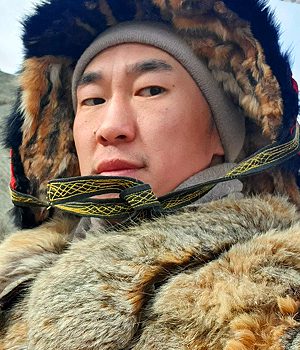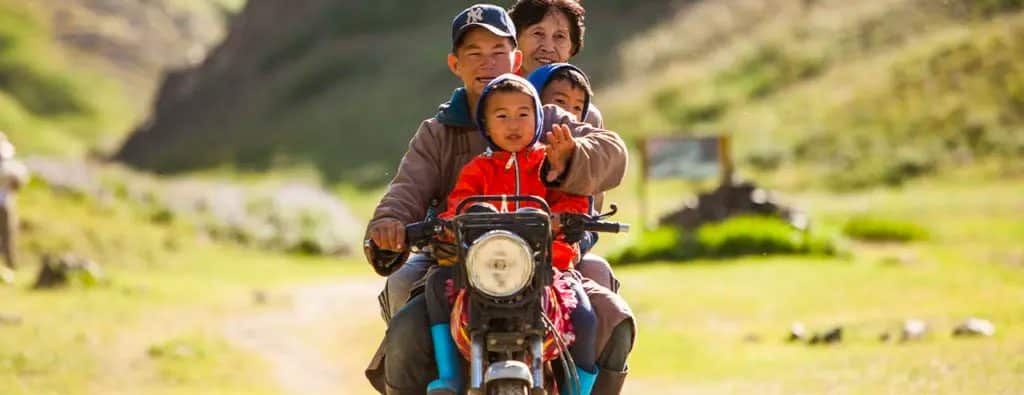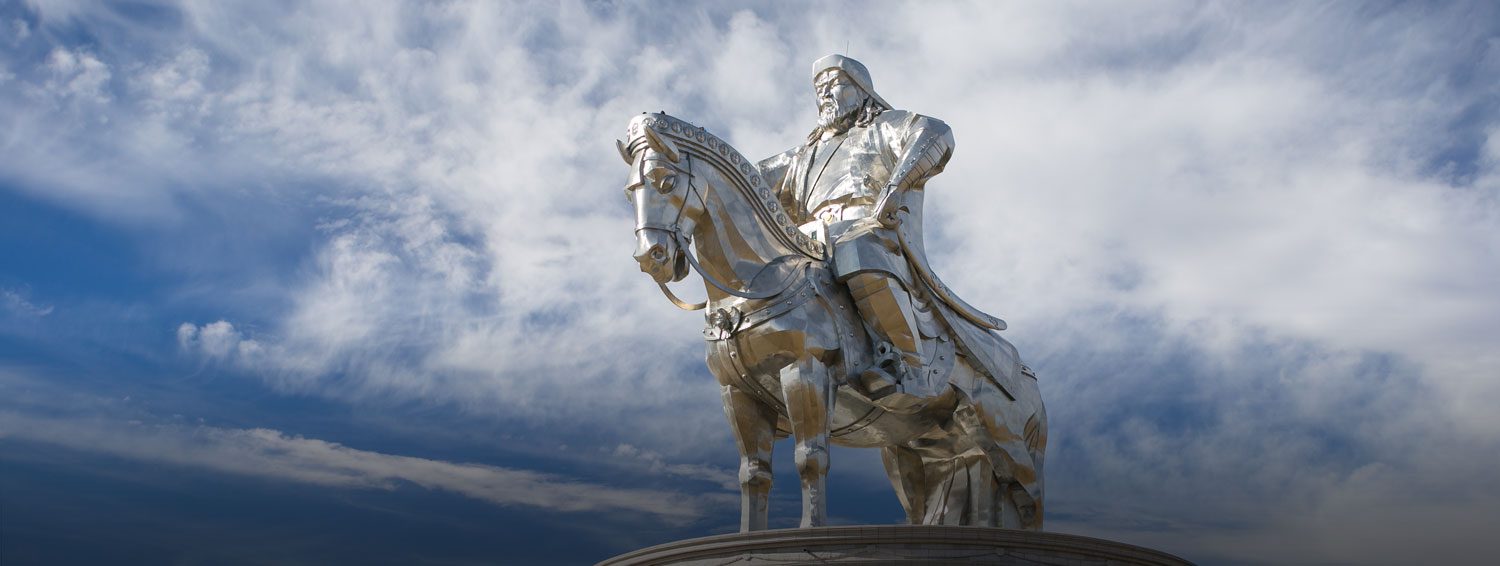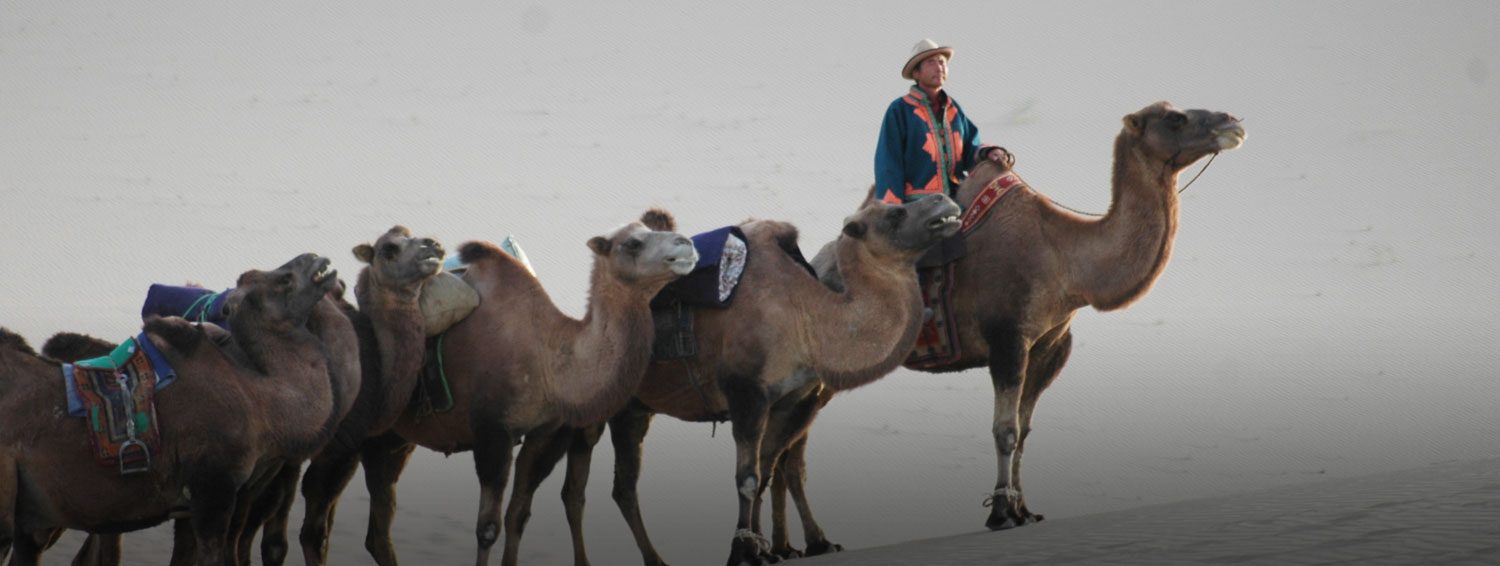MONGOLIA
Mongolian Epic Overland Adventure
This epic off-road adventure showcases some of the most spectacular, varied, and historically important sites in Mongolia. Your journey will traverse the entire country from north to south using four-wheel drive off-road vehicles. Begin at Lake Hovsgol, situated among some of the world’s most pristine forests, mountains, and meadows.
The journey continues south toward the canyons and sand dunes of the Gobi, stopping along the way at ancient deer stones, dormant volcanoes, and the ruins of a 17th-century temple.
This extensive adventure follows an ambitious off-road route where the rest of the world seems millions of miles and hundreds of years away.
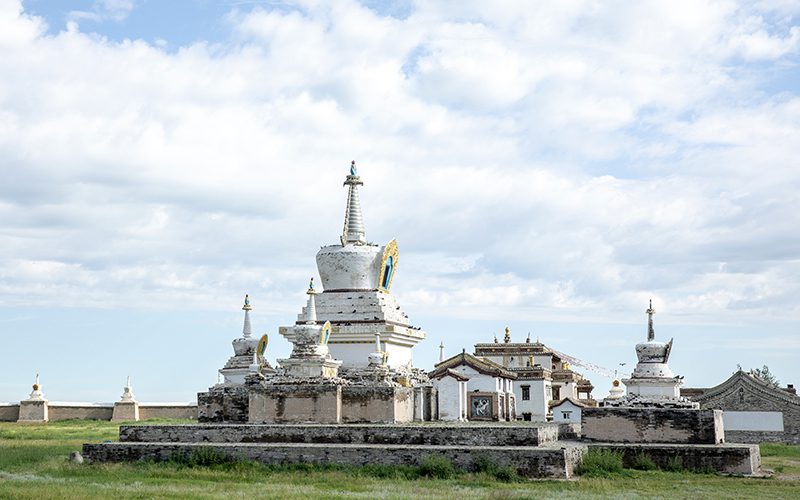
PRIVATE JOURNEY: | May through September |
2 TRAVELERS: | From $11,805 per person |
INTERNAL AIRFARE: | $380 per person |
SINGLE SUPPLEMENT: | $1,760 per person |
Inclusions & Exclusions
LAND PRICE INCLUDES:
- Ground transportation in Mongolia as described in the itinerary
- Transfers upon arrival and departure
- All accommodations based on double or twin occupancy (hotel rooms and gers)
All meals in Mongolia including a camp cook while tenting
- Bottled/filtered water throughout the trip and soft drinks at meals
- All excursions, entrance fees, and visits as described in itinerary
- Extensive pre-departure Travel Guide, reading list, important information about your trip, and luggage tags
- Bilingual Nomadic Expeditions guide throughout your stay.
LAND PRICE DOES NOT INCLUDE:
- International airfare; internal airfare is quoted separately and subject to change by airlines
- Passport and visa fees
- Comprehensive medical and trip insurance
- Airport taxes
- Excess baggage charges
- Photography and video fees
- Tips to guides and drivers
- Food and beverages not included in the group meals
- Items of personal nature, including alcoholic beverages, laundry, and telephone calls
- Other items not specifically mentioned as included
DATES: | May - Oct, 2021 |
2 TRAVELERS: | $9,555 Per Person |
INTERNAL AIRFARE: | $350 Per Person |
NOMADIC EXPEDITIONS
Tour Leaders
EPIC MONGOLIAN OVERLAND ADVENTURES
Photo Gallery
MONGOLIA
MAP
Reviews
Relevant Blogs
Nomadic Lands Through the Lens: Mongolia in Focus
Whether you’re a professional photographer or a world traveler with only a passing appreciation for photography, the beauty of nomadic people and lands is unmistakable—and incredibly alluring—calling you to explore...
READ MOREJack Weatherford Q&A: Insights on Travel and the History of Mongolia
Q&A with New York Times bestselling author Jack Weatherford.
READ MORECarol Tanenbaum – A Photojournal Excerpt
Carol Tanenbaum – A Photojournal Excerpt Lake Hovsgol Feb 19, 2007 — Beginnings The road from Moron to Lake Hovsgol is more the suggestion of a pathway for vehicles than...
READ MOREItinerary
Download ItineraryThe contrast between ancient traditions and a 21st-century democracy is most visible in Ulaanbaatar, where traditional gers and Buddhist monasteries sit side by side with modern high-rises.
Upon arrival at the airport, you are welcomed by your Mongolian guide and transferred to the deluxe Shangri-La Hotel, a luxury hotel located just steps away from various museums and shops.
(Shangri-La Hotel - Deluxe Room)

Begin the day with a visit to Gandan Monastery, the seat of Buddhism in Mongolia. Although Buddhist monasteries were either destroyed or converted into museums during the Stalinist purges of the 1930s, Gandan Monastery continued to operate as a showpiece for government officials. However, in spite of the government’s efforts to suppress Buddhism and other religious beliefs, Mongolia’s spirituality persisted and a significant resurgence of Buddhism began in 1990 when Mongolia became a democratic nation.
Strolling through the monastery grounds, hear the low tones of the horns used to call the lamas to the temple and observe their daily rituals, including the reading of sutras, the teachings of the Buddha. Also visit the recently renovated Chenrezi and Kalachakra Temples, as well as the magnificent statue of Migjid Janraisig, “the lord who looks in every direction.” This 82-foot high statue, gilded in pure gold and clothed with silk and precious stones, completely fills one of Gandan’s temples.
Next, drive through downtown Ulaanbaatar to the National History Museum for an excellent overview of Mongolia’s history and culture. The newly remodeled museum displays traditional implements of daily nomadic life including Stone and Bronze Age artifacts, historical costumes of Mongolia’s minority tribes, sacred religious relics, and agricultural, fishing, and hunting equipment.
After lunch, drive to Zaisan Memorial, built by the former Soviet Union to commemorate fallen soldiers of World War II. Those who climb the 300 steps will be rewarded with a beautiful panoramic view of the capital city, the Tuul River, and the surrounding countryside. In the evening, enjoy dinner at a fine local restaurant. Overnight at the hotel.
(Shangri-La Hotel - Deluxe Room; B, L, D)

After breakfast, fly north to Murun (1.5 hours), the capital of Hovsgol Province, and continue overland to Lake Hovsgol (approximately 2.5 hours), passing through Mongolian steppe and forested mountains and by the Uushigiin Deer Stones.
Uushigiin Deer Stones are comprised of 14 magnificently preserved deer stones, lined up from north to south and often referred to as the “graveyard of deer stones.” The front stone is carved with a human face on top and is the only one of its kind to have been found. Awareness of the Uushigiin Deer Stones has increased recently as a result of the Smithsonian Institute’s research at the site.
Mongolia’s largest lake by water volume, Hovsgol extends 85 miles in length, 18 miles in width, and is fed by over 90 streams and rivers. This crystal-clear alpine lake, known as Mongolia’s “dark blue pearl,” is situated among some of the most pristine forests, mountains, and meadows in the world. There will be ample time to discover the lake’s secrets in the following days.
Overnight in gers.
(Double Lake Ger Camp - Standard Room; B, L, D)

Spend these days exploring the lakeshore and surrounding mountains and meadows. For those interested, there will be opportunities to kayak, visit local nomads’ dwellings, or sample horseback riding. Overnight in gers.
(Double Lake Ger Camp - Standard Room; B, L, D)

Today, continue with your journey south to Zuun Nuur (6 hours), stopping at Murun village for last-minute supplies.
Continue driving south over several mountain passes, including Tariat Pass, the highest pass in Mongolia, and through Jargalant village. Arrive at your ger camp later this afternoon near the river Ider. Overnight in gers.
(Ger Camp - Standard Ger; B, L, D)

In the morning, drive through the beautiful Arkhangai Province, known for the large number of yaks in the country.
In the afternoon, reach the Horgo Volcano (2 hours) and explore this sunken caldera and its volcanic formations. Here, you will also find two unique caves, both natural formations created by the lava of the erupted volcano - “Youth Cave” and “Yellow Dog’s Hell.”
Continue on to crystal-clear Terkhiin Tsagaan Lake (2 hours), known as the “Great White Lake.” This lake is the highlight of Khorgo-Terkhiin Tsagaan Nuur National Park, established for the conservation of spectacular mountain scenery and endangered flora and fauna. The lake was formed thousands of years ago when lava from nearby Horgo Volcano flowed into the Terkh River, creating a natural dam. Overnight in gers.
(Ger Camp - Standard Ger; B, L, D)

After breakfast, drive to Tsetserleg, provincial capital of Arkhangai and considered one of the most beautiful provinces in Mongolia. En route, stop at Taikhar Rock (about 1 hour). The route to Taikhar Rock passes ovoos (stone cairns) erected for local deities, a custom with origins in shamanism, and the first religion to develop amongst the nomads of Central Asia. The pyramid-shaped piles of stones are usually located on the top of a hill or mountain. Worshippers and passers-by walk in a clockwise direction three times around the ovoos and make an offering, usually of three stones, to bring good luck to their journey.
At Tsetserleg, visit the picturesque Zayayn Gegeenii Temple, founded in 1586 and once home to almost 1,000 monks. During the communist purges of the 1930s, the monastery was converted into a museum and thus saved from destruction. It has become the town’s main monastery and now holds weekly religious services and houses many spiritual and sacred artifacts from its days as a museum.
Continue driving to Kharakhorum, site of the 13th century capital of the Mongol Empire (4 hours). The empire created by Chinggis Khan and his descendants was the largest contiguous land empire in recorded history, and its scope has never been matched. Travelers in the 13th century were impressed not only with the beauty of Kharakhorum, but also by the internationalism and openness of this city where traders, intellectuals, and clergy enjoyed religious freedom.
(Nomadic Expeditions Wilderness Camp - Standard Ger; B, L, D)

After breakfast, visit the Kharakhorum Museum (25-minute drive). Founded to showcase the research findings from the ancient capital of Mongolia by the Mongolian and German joint archaeological expedition, the newly established Kharakhorum museum offers fascinating insight into what was once the center of arts, politics, trades, and religions of the world. The museum has two sections: one for the permanent exhibits, and another for the temporary exhibits to introduce the findings of recent or ongoing scientific explorations in the area.
It is impossible to mention Mongolia without conjuring up images of the great warrior, Chinggis Khan. The empire created by Chinggis and his descendants was the largest contiguous land empire in recorded history, and its scope has never been matched. The great Khan and his son created the beautiful and legendary Kharakhorum to serve as the heart of this monolithic empire. At the time, Kharakhorum was one of the largest junctions of the Silk Route, connecting the Oriental world with the West. Unfortunately, this bustling capital was abandoned by Khublai Khan and later fell into ruin.
Our next stop is the nearby Erdene Zuu Monastery. Mongolia’s largest monastery, neighboring Erdene Zuu, was reputedly constructed from the ruins of Kharakhorum in the 16th century. Surrounded by 108 stupas, Erdene Zuu has been a place of Buddhist activity for more than 500 years. Explore the monastery grounds and observe the monks as they perform their prayers and rituals. The temples are richly decorated with spectacular Buddhas, as well as Buddhist art and architecture. Just behind the monastery compound, visit the site of archeological digs being conducted by German archeologists at the former sight of Kharakhorum. Among the findings was an entire foundation of a house with a brick stove and a beautifully forged gold bracelet.
Overnight in gers.
(Nomadic Expeditions Wilderness Camp - Standard Ger; B, L, D)

After breakfast, drive to Ongiin Hiid (approximately 4 hours) and explore the ruins of this 17th-century temple, situated in a beautiful mountainous region. Still known as the “Pearl of the Great Desert,” Ongiin Hiid was one of the largest monasteries in Mongolia until its destruction during the communist purges in 1939.
Overnight in gers.
(Secrets of Ongii Ger Camp - Standard Ger; B, L, D)

Drive to the award-winning Three Camel Lodge (approximately 6 hours) located at Bulagtai Mountain on the edge of Gobi Gurvan Saikhan National Park. The lodge offers a wide variety of activities to travelers from reading a book on Mongolia to watching a documentary about nomadic culture, and from learning traditional Mongolian games to enjoying a relaxing massage.
Overnight in gers.
(Three Camel Lodge - Deluxe Ger; B, L, D)

Contrary to the sameness that the word “desert” suggests, the Gobi is a diverse and fascinating region, and includes the sites of some of the 20th century’s most important paleontological discoveries. Explore the stunning landscape of the Gobi, habitat for Bactrian camels, Argali mountain sheep, goitered gazelle, Golden Eagles, Saker Falcons, jerboas (similar to kangaroo rats), and many endemic reptiles. The Gobi is also home to some of the Northern Hemisphere’s most rare and elusive mammals, such as the dhole, snow leopard, and Gobi bear.
After breakfast, drive to Yol Valley National Park (1.5 hours), cradled in the foothills of the Altai Mountains. Located in the northern part of the Gobi, this surprisingly green valley was once carved by an ancient river, and its remnant streams create ice formations at the base of the valley that sometimes persist as late as July. A hike through this prehistoric canyon leads to the habitat of indigenous vulture-like Lammergeiers. These predatory birds feed primarily on bone marrow, dropping large bones from the sky in an attempt to break them into smaller pieces. Return to the Three Camel Lodge for lunch.
In the afternoon, take an optional drive to Havtsgait Valley (25 minutes), site of ancient rock drawings left by early Gobi settlers. Hundreds of petroglyphs adorn rocks scattered on the top of the mountain.
Return to the lodge for dinner and overnight.
(Three Camel Lodge - Deluxe Ger; B, L, D)

In the morning, drive to Moltsog Els (45 minutes), one of the few regions of the Gobi covered by sand dunes. Meet with your camel wrangler at his home and mount your camels to begin your camel ride to the Moltsog Sand Dune. Return to the lodge for lunch.
In the late afternoon, travel to the legendary Flaming Cliffs (1 hour), named for the red-orange sandstone which glows brilliantly at sunrise and sunset. It was here, in 1922, that Dr. Roy Chapman Andrews and his exploration team from the American Museum of Natural History found the first nest of dinosaur eggs the world had ever seen. To the trained eye, the ancient formations of the Flaming Cliffs are rich with fossils, and paleontological expeditions continue to make significant discoveries at this site.
(Three Camel Lodge - Deluxe Ger; B, L, D)

After breakfast, transfer to Dalazangad Airport for your flight back to Ulaanbaatar (1.5 hours.) Upon arrival you are transferred back to the Shangri-La hotel. The afternoon is at your leisure, to enjoy the Spa facility at your hotel or further explore the town, browse the bazaar for some last minute cashmere shopping. In the evening, enjoy a traditional Mongolian performance featuring khoomi throat singing, followed by a farewell dinner at a fine local restaurant.
Overnight at the hotel.
(Shangri-La Hotel - Deluxe Room; B, L, D)

After breakfast, you are transferred to the airport in time for your departure flight.
(B)
B=Breakfast L=Lunch D=Dinner
Nomadic Expeditions reserves the right to change the above itinerary if necessary.









